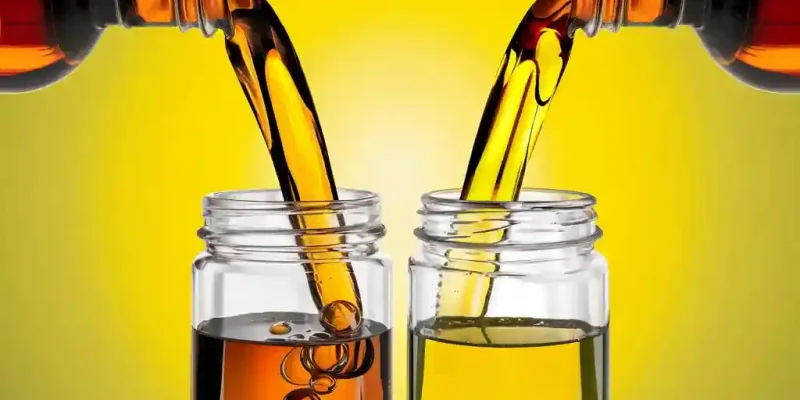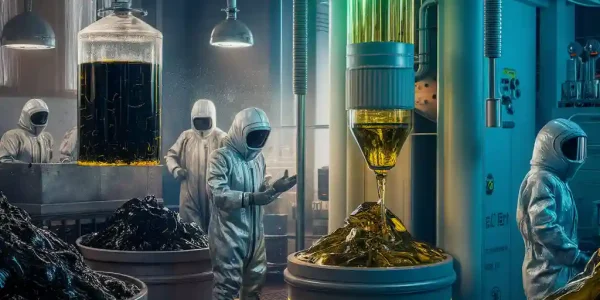- 021-91034194
- Info@pishco.ir
- Tehran, Sa'adat Abad
Home » What is burnt edible oil?
Burnt edible oil and turning it into clean fuel: To understand the importance of the issue, it is better to first know the definition of edible oil: the increase in population and the improvement of living standards have increased the demand for edible oils, because these oils are nutrients and energy needed for activities. They offer daily. Its main edible oils are triacylglyceride and more than 95% of different fatty acids. Free fatty acids, phospholipids, phytosterols, tocopherols and other antioxidants can also be found in these oils. Burnt oil waste contains many harmful substances that can cause serious health risks when consumed, as well as illegal and sanitary disposal of this waste can lead to environmental pollution such as unpleasant odors, water pollution and even steam explosions.
Oils that are used on a daily basis, after production, always contain impurities that must be purified before use. Liquid oils, like vegetable oils, contain suspended and solid particles that require purification through filtration or special chemical processes. These impurities are known under the following headings in edible oils.

Consumption of saturated fats such as modern cooking oils, which are derived from vegetable seeds such as sunflower, soybean, olive and rapeseed, are used in communities, restaurants, fast food and food manufacturing industries. In these processes, due to chemical reactions such as hydrolysis, thermal degradation, oxidation and polymerization, physical and chemical changes occur in cooking oils. Therefore, burnt edible oils contain free fatty acids that cause unpleasant odors and corrosion of metal and concrete elements. This type of waste is classified as municipal waste because of its ability to cause serious environmental problems. On the other hand, this waste appears as a potential source for bioenergy production.
Types of impurities in edible oils are known to include phosphatides or gums, dechained and free fatty acids, and compounds that affect oil color and odor.
Petro Imen Sharif Co. (Pishco) is a knowledge-based company, one of whose activities is the conversion of burnt edible oil into clean fuel or biodiesel. While collecting and buying burnt edible oils from restaurants, hotels, kitchens, etc. across the country, Pishco refines edible oil by using up-to-date knowledge and employing experts.
When the oil reaches a very high temperature (smoke point), its structure changes and loses its stability, as well as chemical changes occur in it. These chemical changes can lead to the creation of carcinogenic substances in the oil, which consumption by humans can lead to various diseases. To better understand this issue, we can refer to a simple example of meat.
Just as a piece of meat cooks healthily and deliciously when it is cooked slowly, but if it is overheated, the meat will burn and turn black after a while. Do you think eating burnt and blackened meat is useful and healthy? Of course not, consuming burnt meat can cause serious health problems.
Just like consuming burnt meat is harmful for us, using burnt oil is also dangerous and can lead to cancer and unknown diseases. This information has been announced based on the research and opinions of experts of the Ministry of Health.
Therefore, to maintain health, use stable oils at the right temperature for cooking and avoid burnt and altered oils to clearly reduce health problems.
So far, the cases that indicate oil burn have not been investigated. You probably know that burning smell is one of the most famous signs of burning oil. But in the following, we will fully explain other signs of oil burns.
The first sign that clearly informs that the oil is burning is its color change. When the oil is heated, its color changes slowly. If the oil is heated too much or if it is heated for a long time, its color will become darker and blacker. Comparing the color of used oil with fresh oil is a good indication of burning and darkening of the oil. So, if you notice a change in the color of your oil and it starts to darken, you should know that the oil is burning. Oils that don’t smell burnt yet may have a slight discoloration, which indicates that the oil has been exposed to too much heat and is close to burning.
Another sign that is more important for multi-use and residual oils is thickening of the oil, which indicates its burn. After using the oil, if you don’t smell a burning smell, you can check to see if the oil has thickened abnormally. If the oil is already soft and thickens significantly after cooling, it may be burnt. This method is used when there are no signs of burning and the oil is left in the container after cooling. In this way, oil burn can be easily detected. Therefore, to store the oil for later use, after it has cooled, check if its concentration has increased.
The most common and at the same time the easiest sign to identify burnt oil is its smell. When the oil reaches a high temperature, or smoke point, and loses its stability, chemical reactions occur in it, resulting in the emission of a burning smell. This unpleasant smell spreads quickly in the environment and everyone quickly notices burning oil or food. If you smell this unpleasant smell, the oil is completely burnt and it is no longer possible to use it.
If you pay close attention, you will notice that when the empty oil is placed in the pan and placed on the heat, after heating a little, the grains below will form on it and the oil will start to make noise. The more time the oil is on the heat, the more these small bubbles and the noise will increase until finally the oil is completely burnt and a foam is formed on it. Creating this foam on the oil means its complete burning.
Oil purification aims to remove undesirable impurities from oil and minimize damage to glycerides. This process consists of several main steps, including degumming, alkaline treatment, decolorization and sterilization. Also, steps such as waxing and winterizing are also performed for some liquid oils, which lose their clarity at refrigerator temperatures due to the deposition of wax and high-melting triglycerides (such as stearin).
Crude oils extracted from oilseeds may contain small amounts of oil-insoluble suspended solids. These substances are removed from the oil using simple filtration or centrifuge decanters. The main impurities of oil include various chemical compounds that are soluble in oil and are removed from oil using certain methods.
One of the important stages of oil refining is dephosphatization, which is the first stage of oil refining. In this step, phosphatides are separated from the oil using phosphoric acid water and citric acid. This stage begins by heating the oil and mixing it with water in a certain ratio, then the phosphatides are removed from the solution and separated from the oil due to their high water absorption properties. Other compounds that may remain dissolved in the oil, such as calcium and magnesium, are removed with the simultaneous use of acid. At this stage, the oil is heated to 150 degrees and by adding a small amount of phosphoric acid, these salts are removed from the oil.
Cleansing of free fatty acids is also done by neutralizing fatty acids using soda. After analyzing the amount of free fatty acids in the oil, the necessary amount of sugar to neutralize them is determined. Finally, by adding soda to the heated oil, the fatty acids are released from the oil. In this step, some remaining impurities from the previous steps such as phosphatides, magnesium, calcium and other salts are also purified from the oil.
Enhancing the color and smell of the oil is another step of purification. Due to chemical reactions, some oils have compounds such as aldehydes and peroxides that affect the smell and taste of the oil. At this stage, these compounds are released from the oil using water vapor pressure at high temperatures, then after cooling, the oil is packaged and marketed.
Danesh Banyan Petro Ayman Sharif company collects and buys edible burnt oil from restaurants, hotels, kitchens, etc. across the country, using up-to-date knowledge and employing experts, refines edible burnt oil and turns it into clean fuel.

Edible burnt oil refers to an oil that has lost its main edible uses due to frequent consumption and the introduction of chemicals and impurities. In other words, this type of oil is not suitable for cooking and edible purposes. Today, by using burnt edible oil purification devices, this type of oil can be collected and after purification, they can be used for various purposes, including city bus fuel.
Refined edible burnt oils can be used in various industries such as soap making, animal and poultry feed, grease making companies, etc.
In this article, we examined burnt edible oil, its treatment and application. But if you have burnt edible oil, you can contact Petro Imen Sharif Technical and Engineering Company (Pishko) to sell your burnt oil at a reasonable price and register your request on our website so that the experts of our company will contact you as soon as possible. It’s time for our colleagues to collect the burnt oil.
While our company’s experts will contact you, our colleagues will collect the burnt oil as soon as possible.
Biodiesel is a renewable and degradable fuel that is obtained from vegetable oils or animal fats. This fuel can be easily mixed with diesel and used in diesel cars. Suspended particles and unburnt hydrocarbons that come out from the exhaust of diesel cars are toxic and carcinogenic and are considered a threat to human health. The positive results of using biodiesel in reducing toxicity and air pollution have been confirmed by reputable global organizations and bodies. For example, the soybean plant absorbs CO2 from the air and converts it into biodiesel after extracting the oil from the soybeans. The combustion of this biodiesel produces CO2, and the CO2 present is reabsorbed by the plant from which the fuel was obtained. This cycle does not cause any carbon dioxide to enter the natural environment.
The oil purifier is one of the machines used to clean different types of edible oils. In recent decades, the process of extracting oil from different seeds has been greatly expanded, and the use of oil refining devices has also increased greatly.
These devices are divided into industrial and semi-industrial types. Industrial models are used for oil factories, while semi-industrial models are mostly used in oil shops. In the food industry, the use of oil refining devices leads to the removal of acids and lards in the oil and improves the final quality of the oil and increases its nutritional value, as well as reducing the harmful effects of the oil.
In order to sell your burnt oil to Petro Ayman Sharif Technical and Engineering Company (Pishko) at a reasonable price and register your request on our website, our company’s experts will contact you as soon as possible and our colleagues will collect it for you. Burnt oil.
Related websites
quick access

Petro Imen Sharif Engineering Company was founded in 2010 by a group of engineers and specialists graduated from top universities in Iran, who believe in the motto “Desire creates” and with a focus on advancing scientific movements in the field of environmental protection.
No. 5, Kaj square, Ali Akbar alley, Saadat Abad, Tehran
Plate 1- West 38 Alley- South Allameh St. -Sadat Abad - Tehran
Saturday to Wednesday 8:15 AM to 4:30 PM Thursdays: 8:15 AM to 1 PM
لطفا فرم زیر را به دقت پر کنید تا مشاورین ما در اسرع وقت با شما تماس حاصل فرمایند.
Please fill out the form below carefully so that our consultants will contact you as soon as possible.